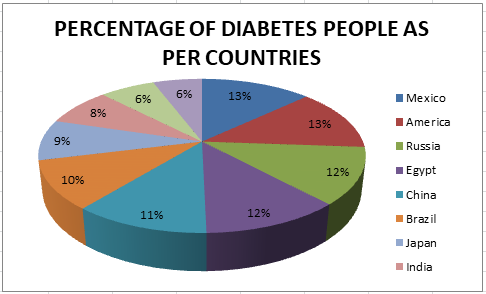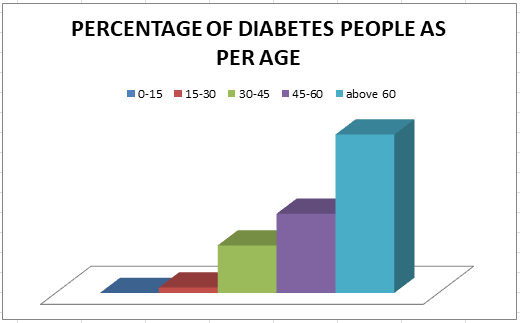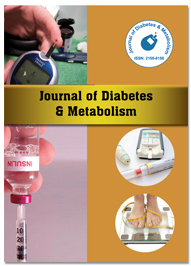Theme: Explore the Latest Trends and Advances in Diabetes and Endocrinology Disorders
worlddiabetes-cs-2021
We are privileged to welcome you to attend the “23rd World Congress on Diabetes and Endocrine Disorders” which is going to be conduct on December 13-14, 2021 and it’s a Webinar. Theme of the conference is “Diabetes and Endocrine Disorders”.
The main intent of the conference is to provide an opportunity to share knowledge, expertise along with a huge number of medical and industrial professionals all around the world. This conference mainly gathers prominent surgeons, scientists, speakers, researchers, industrial delegates, young researchers and talented student communities within the field of Diabetes and Endocrine Disorders.
Why to Attend?
As we all know that most of people in the world have health problems especially the elder people mostly suffer with diabetes. Firstly, the speakers, researchers and other expertise can share their knowledge on this diabetes conference which is going to be held on December 13-14, 2021 and it’s a Webinar Conference. Moreover, it is useful for the student communities who are in same field. As per statics show below it is clear that the elder people who are aged above 45 are mostly effect by diabetes.
Benefits Of Participating In The Conference:
- Exchange ideas and networks with leading diabetics, diabetes researchers, and researchers from more than 40 countries.
- Discuss how to implement quality in all research on diabetes, endocrinology and metabolism, and diabetes and endocrinology diseases and treatments.
- Assemble and discuss key points in conference and challenges with keynotes speakers.
- Through conference, we cover everything from global macroeconomic issues to diplomatic issues.
Sessions and Tracks
In this session different types of tracks are discussed. Those are diabetic types, diabetes symptoms, pre diabetes, diabetes treatment, insulin therapy, anti-diabetes drug, diabetes diagnosis
Track 1: Categories of Diabetes
In general there are two types of diabetes Type 1, Type 2, and Gestational.
Type 1
Type 1 diabetes is also known an autoimmune condition. In this type 1 diabetes your immune system may attacks and destroys the beta cells in pancreas which produce insulin to our body. Moreover, the damage is life long and it cannot be clear. This may attack through environmental reasons and genetic.
Type 2
Type 2 diabetes begins with insulin resistance. This means that your body cannot use insulin effectively. This will stimulate your pancreas to generate more insulin until it cannot keep up with the demand. Insulin production is reduced, leading to high blood sugar. There may chance of unknown cause due to type diabetes those are
- Being overweight
- Lack of exercise
- Genetic
Gestational Diabetes (GDM)
Gestational Diabetes Mellitus (GDM) is a type of diabetes that occurs during pregnancy and is related to complications in the mother and fetus. Gestational diabetes takes place due to insufficient body production of insulin necessary for pregnancy. Therefore, glucose builds up to high levels in the blood, causing hyperglycaemia. Gestational diabetes occurs in the third trimester of pregnancy, and the baby's body has been designed not to cause birth defects.
- Birth Trauma
- Premature Birth
- Polyhydramnios
- Macrosomia
Track 2: Diabetes Symptoms
Diabetes is a disease in which the body cannot produce enough insulin, cannot use normally produced insulin, the body cannot transport the sugar in the blood to the cells. This can lead to high Blood Sugar Level. Glucose, in the form of sugar in the blood, is one of the main sources of energy. Insulin shortage or insulin resistance can cause sugar to accumulate in the blood. This may cause different health problems those may
- Extreme hunger
- Frequent urination
- Unexplained weight loss
- Thirsty
Track 3: Treatment for Diabetes
Treatment of diabetes aims to keep blood glucose levels close to the normal range. This treatment should be different for each person, depending on the type of diabetes a person has. Although, type 1 is generally treated with insulin, type 2 diabetes generally must be controlled with particular diet and exercise. A variety of ant diabetic medications, insulin therapy, surgery, and herbal therapies are available. A particular diet, physical exercise and blood sugar detection must be combined to effectively treat diabetes.
Track 4: Insulin Therapy
This therapy need close monitoring and a great deal of patient education, as improper administration is quite dangerous. For instance, when food taking is reduced, less insulin is recommended. A previously acceptable dosing may be too much if food supply is consumed causing a hypoglycemia reaction if not rationally adjusted. Doing exercise daily may shorten insulin requirements as exercise boost up glucose uptake by body cells whose glucose uptake is composed by insulin and vice versa. Moreover, there are different types of insulin with differing times of onset and period of action.
- Precise acting insulin
- Rapid acting insulin analogs
- Intermediate acting insulin
- Long acting insulin.
Track 5: Anti-Diabetes Drug
Drugs used for diabetes treat diabetes by changing the level of glucose in the blood. Except for insulin, liraglitude, exenatide and pramlinitide they all are administered orally, so they are also called oral hypoglycemic agents or oral hypoglycemic agents. There are different types of Anti-Diabetic Drugs, and their choice depends on the nature of diabetes, the person’s age and condition, and other factors. Type 1 diabetes is a disease caused by insufficient insulin. Insulin must be used for type 1must be injected.
Track 6: Diabetes Diagnosis
With increased awareness and information on preventive measures against deadly diseases like diabetes, consumers are choosing the right foods and medicines. A person can greatly improve their health by changing their diet slightly, while enjoying their favourite foods and having fun with their meals. The diabetes diet is a simple and healthy eating plan that is rich in nutrients, low in fat, and moderate in calories. Given consumer interest in healthy eating and helping prevent diabetes and the risk factors that accompany it, manufacturers are now eager to introduce new low-calorie foods that contain sugar substitutes and less oil.
- Low-carbohydrate diet
- Essential Macronutrients
- Reading food labels
- Foods to avoid
- Weight loss diet.
Track 7: Pediatric Endocrinology
Pediatric endocrinology is the subdivision of medicine and biology, generally involving endocrine gland diseases, variants that affect children's physical or sexual development, diabetes, and many other diseases. The most common disease is especially type 1 Diabetes, which usually accounts for at least 50% of typical clinical practice. Another more common problem is growth disorders, especially those that can be treated with growth hormone.
• Psychological Hypoglycaemia
• Adolescent Gynaecology.
Track 8: Skin Manifestations of Diabetes
Diabetes is a common and debilitating disease that affects many organs including the skin. Between 30% and 70% of people with type 1 and type 2 Diabetes will develop diabetic skin complications at some stage in their lives. Various manifestations of skin diseases are related to diabetes. The severity of these conditions varies, and they may be benign, disfigured, or even life-threatening. These skin changes can provide information about the patient's blood sugar control and may be the first sign of metabolic disorders in undiagnosed diabetic patients. Some common skin conditions in diabetic patients are:
- Diabetes food syndrome
- Limited joint mobility
- Acanthosis nigricans
- Diabetes thick skin.
Track 9: Obesity and Strokes
Just as smoking increases the risk of lung cancer, being overweight the risk of stroke will greatly increases. Due to excessive body fat, inflammation is likely to occur, leading to poor blood flow and possible obstruction, which are the two main causes of stroke.
The risk factors for strokes include:
- Heart and blood vessel diseases
- High blood pressure
- Smoking
- Diabetes
- Brain aneurysms or arteriovenous malformations (AVMs).
Track 10: Treatment for Pregnancy Diabetes People
Gestational diabetes was first diagnosed during pregnancy. For most other types of diabetes, gestational diabetes affects the way cells use sugar. Treating diabetes can lead to high blood sugar, which can affect your pregnancy and the health of your baby. Although pregnancy complications are worrisome, the good news is. But if you have gestational diabetes, your risk for type 2 diabetes is higher. You will need to test for changes in blood sugar levels more frequently.
- A lack of physical activity
- Diabetes in an immediate family member
- Previously delivering a baby weighing more than 9 pounds
- Over weight and obesity.
Track 11: Physical Fitness and Diabetic Nutrition for Diabetes People
Adults with diabetes need at least 150 minutes of moderate intensity physical exercise each week. In addition, experts also recommend resistance and strength exercise at least twice a week. Use sport to fight diabetes. Exercise delays the onset of type 2 diabetes. In addition, it can improve diabetes control. If you have type 1 diabetes or type 2 diabetes, take action! Physical activity: increase your heart rate. Exercise also allows blood to flow to all organs, especially the brain, eyes, and kidneys. Reduce stress, stress increase the risk of diabetes. Moreover, for diabetic patients, stress makes it difficult for them to control their conditions.
Track 12: Diabetes Advanced Technologies
The need for frequent blood glucose tests is an essential, but sometimes unpleasant, factor in the lives of diabetic patients. Testing your blood sugar can help you produce better decisions about what to eat, how much exercise, and how enough insulin you need. CGM (Continuous Blood Glucose Monitoring) can help you avoid needles. A small sensor placed under the skin of your abdomen or arm measures your blood sugar level every few minutes.
- Advanced discoveries and emerging therapies for Type 1 Diabetes
- Modern exploration and treatment for type 2 diabetes
- Recent Therapeutic Mechanism for diabetes
- Exploring Novel Therapy
- Other brand-new medical technologies used in hospitals.
Track 13: Stem Cell Treatment in Diabetes
Autologous hematopoietic stem cells were used in this examination. They are the same as stem cells in cord blood. Since type 1 diabetes (also known as juvenile diabetes) is an autoimmune disease that manifests early in life, it is easy to understand how the results of this study can benefit people who store cord blood at birth. Cord blood is the outshine blood type.
- Treatment of diabetes
- Stem cell therapy
- Type 1 diabetes beta cells
- Stem cells and diabetes
- Stem cell therapy.
Track 14: Challenges of Endocrinology
The endocrine system controls the flow of data between cells and tissues, represented by complex management components. Hormones have a comprehensive impact on completely different metabolic processes to ensure comprehensive management, genetic transformation and capabilities. The signs of endocrine diseases are mainly caused by non-endocrine or unknown causes, such as fatigue, restlessness, deficiencies, migraine, anorexia, depression, weight gain or misfortune. This is the case with diseases of the endocrine glands, which are effectively noticeable in their enormous structure, and it can sometimes be troublesome to land when clearly discovered. Early conclusions and management of endocrine diseases are the foundation, which can be achieved through a combination of intensive endocrine testing, imaging, prudent medical history, physical examination, and reasonable clinical judgment. Sufficient information and understanding of basic science and endocrinology standards are the key equipment to improve the productivity and accuracy of endocrine capacity tests.
Track 15: Risk Factors for Type 2 Diabetes
The average age of onset of type 2 diabetes is being over 45 years old is a risk factor for type 2 diabetes. People of this age and above should take active measures to prevent this, including regular, light to moderate exercise and diet control by taking action on factors that can be changed, you can prevent type 2 diabetes. Some risk factors are
- Overweight or obesity
- Low HDL cholesterol
- Polycystic ovary syndrome
- Depression
- History of heart stroke.
Track 16: Diabetes Diagnostic Tools
Healthcare professionals most commonly use the fasting blood glucose test (FPG) or A1C test to diagnose diabetes. In most cases, they can use a random plasma glucose test (RPG).
- Blood glucose meter
- Blood collection needle
- Diabetes test paper.
Track 17: Preventing Diabetes Problems
Preventing diabetes can lead to serious illness and even death, which is why prevention is so important. Diabetes complications can be divided into two categories:
- Acute (Sudden)
- Chronic (long-term)
Acute Complications
- Diabetic ketoacidosis (DKA)
- Hyperglycaemia and hyperosmolar nonketotic syndrome (HHNS)
Diabetes complications can occur at any time in the course of the disease.
Chronic Complications
- Cardiovascular: Heart Disease, Peripheral Vascular Disease, Stroke
- Eyes: Diabetic Retinopathy, Cataracts, Glaucoma
- Nerve Damage: Neuropathy
- Kidney Damage: Nephropathy
Most Diabetes Related Chronic Diseases and Complications lead to death. It always makes sense to appear after the blood sugar level rises a few years later. If patients with type 2 diabetes may have elevated blood glucose levels several years before diagnosis, these patients may have signs of complications at the time of diabetes.
Track 18: Case Report and Others
Lipid diseases are a group of diseases in which the level of fatty substances in the blood is too high. These fatty substances include cholesterol and triglycerides. Too much bad cholesterol increases the risk of heart disease and stroke. Paraganglioma is a rare neuroendocrine Tumor that can occur in different parts of the body, including the head, neck, chest, and abdomen. About 97% are benign and can be cured by surgical resection; the remaining 3% are malignant tumors because they can produce distant metastases. "Paraganglioma" is currently the most widely used term for these lesions. They are collectively referred to as: glomerular Tumor, chemo dermal Tumor, peripheral skin Tumor, fibro vascular Tumor and congenital nevi. Disorders of bone strength metabolism are usually caused by deviations in minerals (such as calcium or phosphorus (P)), vitamin D, bone mass, or bone structure. The most common bone metabolism disease is osteoporosis.
Track 19: The Role of Steroids and Hormones in Obesity
Sex steroid hormones are related to the metabolism, accumulation and distribution of adipose tissue. Recent studies have shown that there are progesterone receptors, estrogenic receptors and androgen receptors in adipose tissue, so their effects may be direct. Sex steroid hormones act in adipose tissue through non-genomic and genomic mechanisms.
- Metabolic role of steroid hormones in obesity
- Steroid hormones in our diet and obesity
- Obesity and corticosteroids.
Track 20: Traditional Chinese Medicine and Acupuncture
Traditional Chinese Medicine is a consider as one of the most preferred traditional medicine, usually based on more than 2500 years of Chinese medicine practice, including various forms of herbal medicine, acupuncture, massage, exercise and nutritional therapy to prevent health problems. In acupuncture, thin needles are inserted into the body. It is usually safe to perform acupuncture correctly by a well-trained doctor using clean disposable acupuncture techniques.
- Chinese herbal medicine
- Tui-na
- Nutrition therapy.
According to a new report from the Centre’s for Disease Control Prevention (CDC), more than 100 million American adults now have diabetes. The number of diabetic patients increased from 108 million in 1980 to 422 million in the year 2018. It is growing fastest in low –income countries. Diabetes is one of the main causes of vision problems, heart attacks, kidney failure, and strokes. Another 2.2 million people died of hyperglycaemia in 2019. Almost half of deaths caused by high blood sugar occur before age 70. Does the WHO estimate that diabetes is the seventh leading cause of death in 2025? The popularity of diabetes in all age groups worldwide is predicted at 3% of 3,000 people and 5.2% of every 2,080 people.

Summary
Diabetes and Endocrine Disorders conference 2021 aims to increase health awareness, including plenary lectures, group discussions and seminars, patient/doctor education materials, and home monitoring/telemetry. The goal is to convene a multidisciplinary team to identify important issues related to Diabetes and Endocrine Disorders in the world. In particular, an obstacle to the wider identification of diseases and the development of well-planned action plans. More than 500 scientists, clinicians, respiratory therapists, nurses, patients, government officials and representatives of pharmaceutical companies will participate in Diabetes and Endocrine Disorders Conference 2021. The summary provides recommendations from the meeting, which will be used to develop an action plan for the Diabetes citizens all around the world.
Importance of Scope
With the increase in the number of patients around the world, the need for therapeutic measures to stop the development of the disease and enhance its secondary manifestations has never been so strong and urgent. World diabetes 2021 conference will showcase the latest expansions in research, management and diagnosis, new insulin analogues, and new technologies and equipment for the prevention of diabetes and the treatment of obesity, etc. World Diabetes Conference 2021 will not only enhance your theoretical and practical knowledge, but will also provide you with a unique opportunity to connect with a wide range of professionals in the field of diabetes technology and endocrine disorders and its research.

Related Key Words:
Diabetes Event | Weight loss Event | Diabetes and Endocrine Expo | Endocrine conferences | Diabetes Meet | Europe Diabetes Conferences | Congress on Diabetes | Endocrine Diseases Congress | Diabetes Expo | Global Meet on Diabetes.
Diabetes Associations:
- Children’s Diabetes Foundation
- The Diatribe Foundation
- Diabetes Sisters
- Diabetes Hand Foundation
- The Diabetes Research Institute Foundation (DRI)
- American Diabetes Association
- Joslin Diabetes Center
- Taking Control of Your Diabetes (TCOYD).
Research Institutes of Diabetes
- University of Colorado System (Boulder)
- University of Cambridge (United Kingdom)
- University of Washington (United States)
- University of Miami (Florida)
- University of Pittsburgh (Pennsylvania)
- CIHR institute of nutrition, metabolism and diabetes (Canada)
- American diabetes association (United States)
- Alberta diabetes institute (Canada)
- University of Toronto (Canada)
- Yale University (Connecticut)
- University of North Carolina (Chapel Hill)
- University of Pennsylvania (United States)
- University of Texas Southwestern Medical Center (Dallas)
- University of Texas Health Science center (San Antonio)
- Duke University (North Carolina)
- Johns Hopkins University (Baltimore)
Conference Highlights
- Traditional Chinese Medicine and Acupuncture
- Diabetes Symptoms
- Treatment for Diabetes
- Insulin Therapy
- Anti-Diabetes Drug
- Diabetes Diagnosis
- Pediatric Endocrinology
- Skin Manifestations of Diabetes
- Obesity and Strokes
- Treatment for Pregnancy Diabetes People
- Physical Fitness and Diabetic Nutrition for Diabetes People
- Diabetes Advanced Technologies
- Stem Cell Treatment in Diabetes
- Challenges of Endocrinology
- Risk Factors for Type 2 Diabetes
- Diabetes Diagnostic Tools
- Preventing Diabetes Problems
- Case Report and Others
- The Role of Steroids and Hormones in Obesity
- Categories of Diabetes
To share your views and research, please click here to register for the Conference.
To Collaborate Scientific Professionals around the World
| Conference Date | December 13-14, 2021 | ||
| Sponsors & Exhibitors |
|
||
| Speaker Opportunity Closed | |||
| Poster Opportunity Closed | Click Here to View | ||
Useful Links
Special Issues
All accepted abstracts will be published in respective Our International Journals.
- Endocrinology & Metabolic Syndrome
- Endocrinology & Diabetes Research
- Journal of Diabetes & Metabolism
Abstracts will be provided with Digital Object Identifier by





